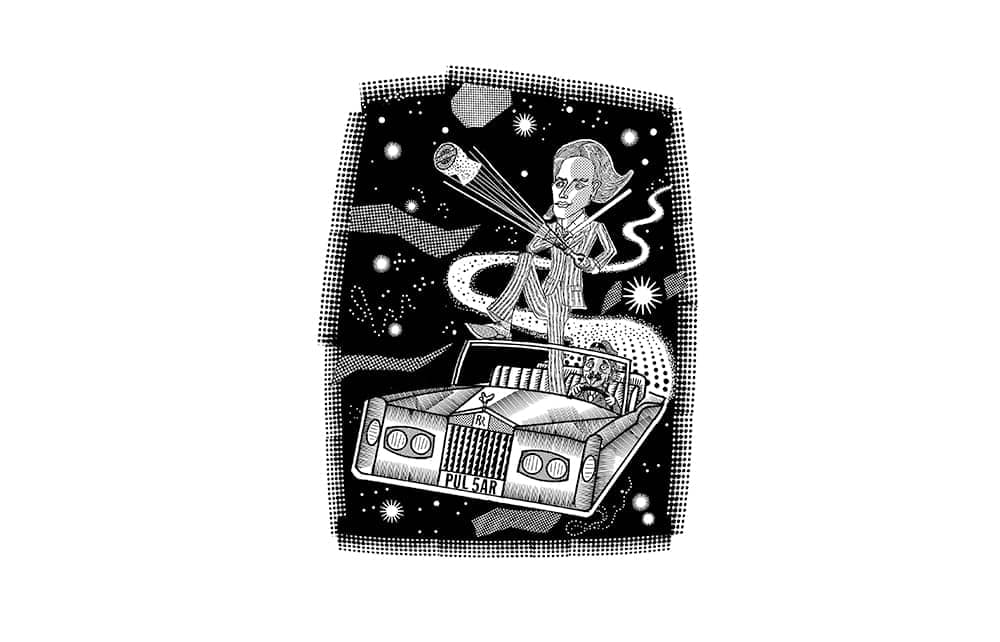Long involvement in The Spectator’s Economic Innovator Awards has taught me that entrepreneurs come in all shapes and sizes. Even so, when I met the founder of a British rocket-science venture called Pulsar Fusion, I was looking for a bespectacled boffin rather than someone I might have presumed was a musical-theatre actor – or a star of one of those TV reality shows populated only by the young, fit and blond, such as Made In Chelsea.
Well, guess what: 35-year-old Richard Dinan actually was a star of Made in Chelsea and he has the teeth, hair and cheekbones to prove it. But he’s also been a serial start-up entrepreneur since he was 16 and now he’s a self-taught astrophysicist as well. ‘Not really a scientist,’ he explains with a hint of apology. ‘But I’ve always loved technology and building things. I guess I’m a natural engineer.’
Bypassing university, Dinan trained briefly as a gunsmith before venturing into 3D printing, robotics, high-frequency trading and fintech. When in his late twenties he began to make money, ‘not spectacular but enough’, he didn’t blow iton fast cars or Chelsea girls. Instead, he ‘hired some physicists and started asking them difficult questions’. Fascinated by asteroids and meteorites – ‘hydrogen cooked into iron, the waste product of stars’ – he had found his life’s passion in the esoteric field of nuclear fusion.
What’s nuclear fusion? If you’re guessing something to do with power-station technology, you’re not entirely wrong – you’re just three or four decades too early. Sometime in the second half of this century, fusion could indeed become the source of the abundant clean energy that human civilisation will need to survive.
But it’s not what drives Hinkley Point and Sizewell today. That is nuclear fission – the splitting of atoms to release energy. Fusion, sometimes described as ‘the process that drives the stars’, is the opposite use of the same natural phenomena: the fusing together of different forms of hydrogen atom at ultra-high temperatures (millions of degrees Celsius, that is) to release colossal amounts of energy that could eventually drive turbines to generate electricity.
All nuclear physics goes back to Albert Einstein, but fission was first developed in the 1940s to make atom bombs. Fusion, more difficult to achieve, less lethal in potential use, has been ‘held back by bureaucracy’ all these years, Dinan says, but is now approaching a point of breakthrough. The JET laboratory at Culham in Oxfordshire first created a small fusion reaction 25 years ago. Earlier this year, it reached a new level with a five-second fusion burst from a plasma (or superheated gas cloud), contained within a big magnetic doughnut ring, that generated enough electricity to boil 60 kettles.
‘Trillions of dollars are about to migrate out of combustion assets and find their way into nuclear fusion’
This modest output was hailed as a triumph of patient science. It will be followed by the completion of a much larger version of a similar rig at ITER (International Thermonuclear Experimental Reactor), a 35-nation collaboration sited at Saint-Paul-lez-Durance in Provence that’s due to be switched on in 2025. JET’s test run used more electricity to reach critical temperature than it could generate in return. ITER is expected to achieve ‘breakeven’ or better – and if it does so without mishap, a cautious step-by-step development process will follow to turn fusion into a safe source of everyday power. Meanwhile, China is believed to be pursuing its own path to that objective and may or may not get there first.
So where in this multinational, multi-billion, multi-decade project does Richard Dinan fit – with his £2 million of seed capital, his teach-yourself textbooks and his industrial unit in Milton Keynes kitted out with refurbed vacuum chambers and robots? The answer is not that he’s trying to build the first fusion power station – only governments partnered with giant corporations have the capacity to do that. It’s that he wants to deploy the technology in space, to achieve rocket speeds that would reach Mars in two weeks (Nasa currently indicates seven months) or Alpha Centauri, our nearest star, in 11 years rather than several lifetimes.
Mind-boggling stuff, but Dinan makes it sound both feasible and poetic at the same time. The cold vacuum of space is the perfect environment in which to create and contain the plasma whose energy can be converted to amazing speed without burning, or even needing to carry, any form of carbon fuel.
That makes it a practical business proposition, he says, because there’s already a lot of traffic up there and ‘in the short term, if you’ve got machinery in space I can save you money’. In the longer term, ‘a mature human species that can create a star, which is what the fusion reaction does, is one that can power its planet, or leave its solar system, without creating too many carbon emissions. Give us time, that’s who we are.’
As to raising the capital he’ll need to sustain a project with no fixed timeline or end-date, ‘if ITER works, it will create a massive amount of interest in fusion – and a rising tide should lift all boats. Trillions of dollars are about to migrate out of combustion assets and find their way into fusion’.
And if one of the giant corporations that are looking at fusion possibilities – the likes of BAE Systems in the UK or Raytheon from the US – were to make him an offer for his work, would he take the money and ease back? ‘No, this technology’s still in its infancy. This is not something that you’d just flip, because there’s a lifetime’s work in it.’
Does all this, I wondered, make Dinan Milton Keynes’s answer to Elon Musk – but without the billions, the arrogance and the Twitter obsession? Dinan is an admirer of Musk’s SpaceX rocket venture, which he says has significantly advanced the technology of putting stuff into orbit while demonstrating that the private sector can be more nimble than state-backed institutions such as Nasa. In fact Dinan is the guy who might one day make possible Musk’s wackiest dream of building cities on Mars, by providing the propulsion to get there.
Politely, I’ve left Made in Chelsea until the end of our conversation. Dinan featured in it only for a couple of years in the mid-2010s but he’ll be on YouTube for ever, chatting to some other hunk about whether or not he ‘hooked up with Toff’ – for the uninitiated, that’s Georgia Toffolo, now a rising star in Conservative circles. But he says he did the show partly to gain social-media traction for his earlier ventures – and now, of course, the connection makes Pulsar Fusion a more intriguing subject for journalists like me. So he has no regrets, even if it did give him ‘a paranoia’ that made him study twice as hard because he couldn’t face standing up at conferences and being pointed out as ‘that guy off the telly who doesn’t know an effing thing about nuclear fusion’.
In fact, after an hour in his company, I’m prepared to believe he’s taught himself every-thing there is to know about it. Whether his vision will translate into commercial success in this decade or the next is another question: it’s certainly way too early-stage for our Economic Innovator awards. But if we offered a prize for the most messianic advocate of a science that might one day change our known universe, Richard Dinan would be, in every possible sense, a very hot contender.







Comments